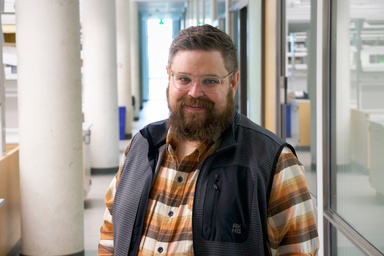Using an incredibly large database of patient information, University of Iowa researchers discovered significant delays in ALS diagnosis for rural patients compared to urban counterparts. Quality of life could be improved for rural patients if health care professionals can find ways to address these delays.
“Even without a cure, there are things we can do for these patients. We can help set up physical and occupational therapies that could really improve quality of life and help them live longer,” says Jacob Simmering, PhD, lead investigator and an assistant professor of internal medicine in the Carver College of Medicine.
Using an insurance database, Simmering's team combed through approximately 20,000 records of individuals diagnosed with Amyotrophic Lateral Sclerosis (ALS)—commonly known as Lou Gehrig’s disease—and matched them to nearly 100,000 controls. Researchers looked to see how the disease presents differently in rural areas compared to more urban ones.
The results
The newly published research indicates how essential more obvious symptoms are for rural patients to be diagnosed with ALS, in part due to delays in care.
“The threshold to get a diagnosis is higher in rural areas, meaning someone with undiagnosed ALS might have a primary care provider who isn’t very familiar with the disease and may not recognize early symptoms,” Simmering says. “Diagnostic sensitivity seems to be lower in rural areas, and sometimes these obvious symptoms are like a canary in a coal mine.”
Did you know that UI Health Care has an ALS clinic in Johnston?
Simmering’s findings also show rural patients are generally diagnosed at later stages of ALS and at older ages than their urban counterparts. He believes this may be because accessing health care services in rural areas is often more difficult for patients.
“Because we think the risk of developing this disease should be the same in both places, we think that observed difference in age at diagnosis reflects delays in care for rural areas compared to urban areas,” Simmering says. “So, rural patients come in a couple of years further along in their disease course, and they're getting diagnosed with presumably a more severe disease and not receiving the kinds of treatments that could improve quality of life.”
With the ALS Association reporting the mean survival time after diagnosis being two to five years, Simmering says many individuals could be living with symptoms before diagnosis, therefore before treatment. He does believe that if the public and health care professionals could become more sensitive to the illness, it’s possible to diagnose it earlier.
“A lot of people don't have access to definitive specialist care, particularly in rural areas,” Simmering says. “And so it's not surprising that they are more dependent on classic symptoms and more dependent on more pronounced symptomology to get a diagnosis when they live in rural areas compared to urban areas.”
Interface with the problem

When it comes to studying how to address diseases and health challenges facing our society, there is an urban bias, Simmering says, and part of it is simply because of how we conduct research.
“When you do a clinical trial, you're going to disproportionately recruit people who live near the clinical trial center, which is probably going to be where the neurologist is, which is probably going to be a tertiary care center or a large teaching hospital, which is going to be in an urban area. These clinical trial sites aren't usually located in rural areas,” he says.
One of the findings researchers can take away from Simmering’s work is thinking about how certain interventions for neurodegenerative diseases—like ALS or Parkinson’s—will play out differently in a rural environment compared to an urban one. In urban areas, people may be more comfortable with technology, have experience with more novel medical procedures, and have greater access to broadband, just to name a few key differences.
“If our plan to improve ALS diagnosis is simply to hire or train more ALS physicians that are going to practice at tertiary care medical centers, that's not going to improve the situation because it's not going to address the access problem that we're facing. I believe we need to think about how what we do is going to interface with what that problem is.”
In addition to Simmering, the UI research team also included Andrea Swenson, MD, and Nandakumar Narayanan, MD, PhD, both of the UI Department of Neurology, as well as Alexander Hart, MD, of the University of Michigan.
Simmering was supported by a faculty fellowship through the Iowa Neuroscience Institute.